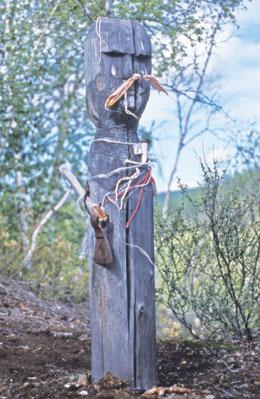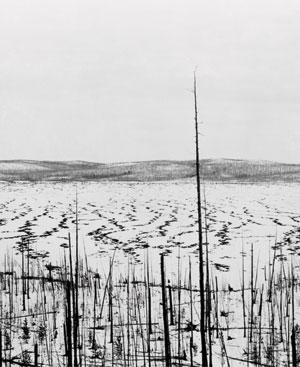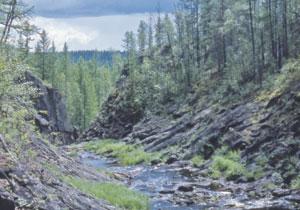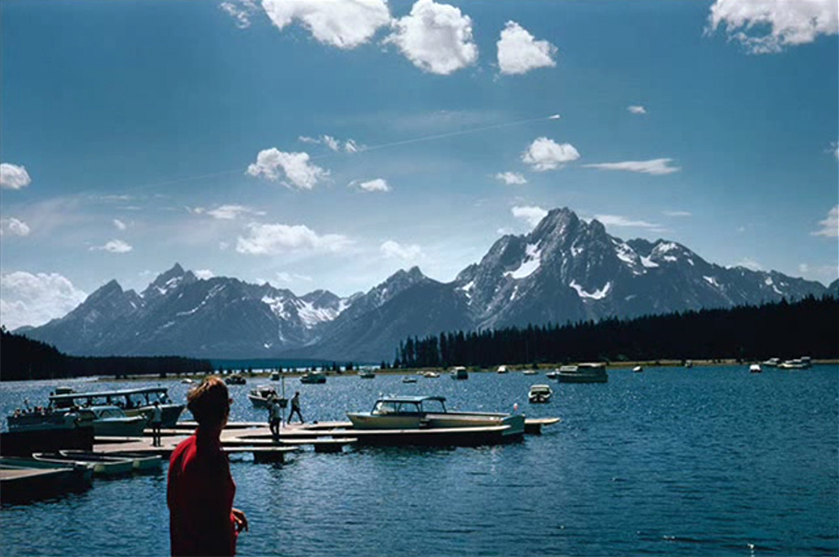

Posted on 06/25/2008 8:30:57 PM PDT by neverdem
The most dramatic cosmic impact in recent history has gathered up almost as many weird explanations as it knocked down trees, writes Duncan Steel.

Sooner or later, it was bound to happen. On June 30, 1908, Moscow escaped destruction by three hours and four thousand kilometers — a margin invisibly small by the standards of the universe.
So begins Rendezvous with Rama , a 1972 novel by Arthur C. Clarke in which mankind learns the hard way about the dangers posed by incoming asteroids. The 2077 impact in northern Italy that Clarke goes on to describe is fictional: the 1908 blast was real. The early morning of 30 June 1908 saw, in an area around the Stony Tunguska river, the most explosive cosmic impact in recent history, hundreds of times more powerful than the atomic weapons set off over Hiroshima and Nagasaki.
And yet, in part because it happened so far from civilization, and in part because it left no crater, it has not always been recognized as such. For decades it existed in a strange realm between science and pseudoscience, blamed on antimatter, black holes and alien spacecraft as easily as on a very fast bit of interplanetary refuse, and developing a mystique that has seen it associated with everything from energy drinks and rock bands to military missiles and The X-Files .
 The totem of the thunder god at the Tunguska site.M. E. BAILEY/ARMAGH OBSERVATORY
The totem of the thunder god at the Tunguska site.M. E. BAILEY/ARMAGH OBSERVATORYThe approximate site of the blast's epicentre is now marked by a totem pole that researchers have dedicated to Agdy, the god of thunder in local mythology. Getting there is quite a trek, but the fascination of the site still draws an intermittent stream of scientists to the remote wilderness about 1,000 kilometres north of Lake Baikal; they leave offerings at the totem pole to commemorate the trek. In the years directly after the blast, though, no one came at all. The first researchers did not arrive until the 1920s.
That does not mean there was no significant contemporary evidence to bring to bear. Siberia was and is an empty place — but a blast which, had it happened over Chicago, would have been heard from Georgia to the Dakotas, still drew a lot of attention. In the days following the blast, A. V. Voznesenskij, the director of the Irkutsk magnetic and meteorological observatory near Lake Baikal, began collecting accounts that are vivid with detail1. There are people being knocked off their feet, a man needing to hold onto his plough to avoid being swept away by a powerful wind, the feeling of great heat “as if my shirt had caught fireâ€, herds of hundreds of reindeer being killed, trees set alight by the radiance of the fireball only for the flames to be snuffed out by the subsequent blast wave. And the reports are unequivocal on the source of the blast. G. K. Kulesh, head of a meteorological station at Kurensk, 200 kilometres from the epicentre, told Voznesenskij that:
“A meteorite of very enormous dimensions had fallen.”
G. K. Kulesh
There appeared in the northwest a fiery column ... in the form of a spear. When the column disappeared, there were heard five strong, abrupt bangs, like from a cannon, following quickly and distinctly one after another ... there had been a strong shaking of the ground, such that the window glass was broken in the houses ... It is probably established that a meteorite of very enormous dimensions had fallen.
In the days after the blast, much of Europe experienced eerie 'bright nights': readers wrote to The Times in London, remarking that its columns could be read outdoors at midnight. Polarization measurements are consistent with this being due to sunlight scattered by dust in the very high atmosphere; observatories recorded increased atmospheric opacity and scattering across the Northern Hemisphere. This spreading dust may have been due to a plume ejected backwards along the incoming object's path by its explosion. Such plumes were seen on Jupiter when the fragments of Comet Shoemaker-Levy 9 slammed into it in 1994; hydrodynamic modelling by Mark Boslough and his colleagues at Sandia National Laboratories in Albuquerque, New Mexico, indicates that a similar terrestrial plume could be expected for an impact such as that at Tunguska2.
 In 1929, more than 20 years after the explosion, dead trees at Tunguska stand witness to the scale of the event.NAT. HIST. MUS., LONDON
In 1929, more than 20 years after the explosion, dead trees at Tunguska stand witness to the scale of the event.NAT. HIST. MUS., LONDONThere was, however, one good reason to doubt that a small asteroid was involved: the belief of the time that this would deliver a valuable hunk of iron to the surface. The Russian meteorite hunter Leonid Kulik, who led the first expedition to the epicentre in the 1920s, obtained funding from the Soviet government on the basis that he would find a valuable ore body there. But when he reached his goal in 1927 he found no metal. Nor did he find the crater that an impact was expected to leave. (There are now claims that nearby Lake Cheko might be such a crater, but these are widely disputed.) There were clear signs of violence - trees knocked flat over a vast swath of land - but no big hole in the ground. What could have happened?
In 1930, US astrophysicist Harlow Shapley suggested that the lack of a crater was due to the nature of the impactor. If it had been a comet, and comets were light and fluffy, then it would have exploded at altitude. This idea persisted for decades: in 1982 some planetary scientists were willing to postulate the extraordinarily low density of 3 kilograms per cubic metre in order to explain Tunguska in terms of the blast from a disintegrating comet.
Other explanations were even more far fetched than candyfloss comets. Soviet science-fiction author Alexander Kazantsev realized, as Shapley had, that the best explanation involved an explosion at altitude, and suggested in 1946 that a nuclear-powered alien spaceship exploding just before landing might have been the culprit, an idea taken up eagerly and earnestly in the following decades.

A more scientifically promising possibility was naturally occurring antimatter, a suggestion made independently by various people at various times. In 1940, Vladimir Rojansky of Union College, Schenectady, New York, suggested that some meteors and comets might be made of antimatter - 'contraterrene' matter in the terms of the time - and that their odd behaviour might be detectable3. (More than 30 years later Rojansky suggested that it would be worth checking if Comet Kohoutek was one of the antimatter ones.) In 1941, Lincoln LaPaz of Ohio State University in Columbus published two articles in the magazine Popular Astronomy that argued that large terrestrial craters and the craterless Tunguska explosion were bothdue to antimatter meteors; he later wrote to the Soviet Academy of Sciences suggesting a search for anomalous isotopes at the site.
More than a decade later, Philip Wyatt, a graduate student at Florida State University in Tallahassee, and Boris Podolsky, author of a famous paper with Einstein exploring apparent paradoxes of quantum mechanics, went to a movie in which antimatter featured. Podolsky pointed Wyatt towards Rojansky's 1940 paper and suggested he look into the impacts idea. Wyatt - now the chief executive of the Wyatt Technology Corporation in Santa Barbara, California - says that he was "mostly interested in looking for residual radioactivity" and published some ideas on the subject in Nature 4.
“Other explanations were even more far fetched than candyfloss comets.”
This notion was expanded on by three eminent American scientists (including 1960 Nobel Prize winner Willard Libby and Clyde Cowan, co-discoverer of the neutrino) in 1965. Libby, the original developer of the carbon-14 dating technique, found support for the idea of an antimatter impact from what seemed to be an elevated carbon-14 level in tree rings around the world in 1909, suggesting that significant quantities of the isotope had been created by radiation given off when the antimatter annihilated itself on contact with the thicker layers of the atmosphere5. Even at the time, though, there were good arguments against the idea: among other things, the first gamma-ray-detecting satellites were not seeing the tell-tale radiation from antimatter annihilation elsewhere in the nearby cosmos.
Even more extreme, in 1973 two University of Texas physicists suggested that the cause was a black hole passing through Earth6. This was nothing if not fashionable: miniature black holes had just been postulated by Stephen Hawking as after-effects of the Big Bang. Again the explanation was incomplete and its implications - an exit on the other side of the planet, and a seismic signal lasting well after the initial impact - unobserved. Similar caveats apply to the intriguing hybrid idea, aired as recently as 1989, that the culprit was a deuterium-rich comet turned into a hydrogen bomb by the heat and pressure of its arrival in the atmosphere.
 The Churgin creek flows past Tunguska's epicentre, its forests regrown.M. E. BAILEY/ARMAGH OBSERVATORY
The Churgin creek flows past Tunguska's epicentre, its forests regrown.M. E. BAILEY/ARMAGH OBSERVATORYAnother approach has been to suggest that, despite the straightforward implications of eyewitness accounts of a bright object zipping across the sky, the source of the blast was in fact beneath the surface. A recent example is a claim that it was due to a 10-million-tonne belch of methane that subsequently exploded high in the sky. Others see a geophysical source involving peculiar tectonic behaviour.
The fact that such ideas were entertained (and still are, in some circles) speaks both of a certain fascination with the fanciful and the abiding need to explain that confusing lack of a crater. The fact that, by the 1960s, various craters around the world had been accepted as meteorite strikes meant that the anomalous lack seemed all the more confusing. In 1993 that confusion was allayed, at least for most people, by Chris Chyba, Kevin Zahnle and Paul Thomas7. With the help of computer simulations derived from nuclear weapons' tests they showed that a solid, stony object about 50 metres across - the most likely sort of thing in that size range to hit the Earth - would not be expected to reach the ground. There was no need to invoke weirdly low cometary densities - at the relevant speeds the shock wave generated within a solid body as it slams into the atmosphere would rip up an everyday rock just fine. Formations such as Meteor Crater in Arizona (see page 1172) are left by tougher impactors made of metal; the shock waves don't get the better of them until they've reached the ground.
A similar explanation was arrived at by Jack Hills, working at Los Alamos National Laboratory in New Mexico with Patrick Goda8, and both teams had been to some extent pre-empted by a Soviet team led by V. P. Korobeinikov, the work of which had not been widely appreciated in the West9. These various models led to an estimate that the blast was equivalent to about 15 megatonnes of high explosive — bigger than all but the very largest thermonuclear weapons. However, work by Boslough indicates that the energy required to fit the observed phenomena could be rather less, around 3 to 5 megatonnes.
That analysis assumes that the impactor was a stony asteroid — but a comet is still a possibility. In 1978, L'ubor Kresák suggested the Tunguska impactor was a fragment of Comet Encke[10]. The peak of an annual intense meteor shower associated with dust from Encke occurred around 30 June 1908, but because the meteors arrived from the direction of the Sun, the shower would not have been visible to the naked eye. What the eyewitnesses said about the direction of the Tunguska projectile is consistent with that idea. An analysis of many hundreds of possible pre-impact orbits for the object published in 2001, by a team that had been led by the late Paolo Farinella, indicated that an asteroidal orbit was more likely than a cometary orbit[11] — but using that paper's definitions, Comet Encke, which takes just 40 months to orbit the Sun, has an asteroidal orbit. Another line of evidence, suggested in 1977, was that a comet might explain the carbon-14 signature reported by Cowan in the 1960s; a comet in space might naturally be thoroughly irradiated[12].
The question of what the object was is not purely academic. If Tunguska was indeed a 15-megatonne event, it was rather unlikely — such things are expected only every 1,500 years or so. That calculation, though, assumes that the flux of near-Earth objects is constant over time. If the population of near-Earth objects is replenished from time to time by the break-up of a comet, then shortly after that break-up, impacts from Tunguska-sized fragments will be more likely. Earth may suffer near misses from Tunguska's dark and stealthy cousins every time it passes through Encke's dust stream — fragments too small to be easily observed, but big enough to cause quite a mess if they hit.
In Rendezvous with Rama , Clarke's solution to the threat of impacts was an asteroid search programme aimed at ensuring that such a catastrophe could never occur again: he called it Project Spaceguard (see page 1178). This became the name of a real-life programme, and that search continues. But 50-metre objects are too small to spot far in advance of their impact. So although another Tunguska coming out of the blue is not a likely event in any given June, it is not out of the question.
Duncan Steel is an astronomer and writer after whom Arthur C. Clarke once named a robot.
See Editorial, page 1143, News Feature, page 1170, and Commentary, page 1178 .
bttt
Truly scary thing is this was caused by an object only about 150 feet wide.
A not-a-waterfall but not-a-geological article for you.
**Truly scary thing is this was caused by an object only about 150 feet wide.**
You are dead wrong...it was caused by global warming.
It was Nikola Tesla testing his “death ray”. It worked. Period.
In other words... Bush’s fault.
btt
City Is Pushing for H.I.V. Tests for All in Bronx
Gene Variant May Contribute to Alzheimer's Disease
FReepmail me if you want on or off my health and science ping list. Anyone can post any unposted link as they see fit.
And I’m sure Climate Change only increases the risk.
When I first read about this, when I was in grade school, I read that if it had hit earth three hours later it would have wiped out St. Petersburg. This article says Moscow. What is the latitude of the impact site? From the map it appears to be somewhat further north than the northern end of Lake Baikal, so further north than Moscow, but roughly the same latitude as St. Petersburg.

The actual film footage is now on YouTube (isn't everything?). Google with the words "Teton" and "fireball" (don't use the phrase "Teton fireball").
I saw a long fireball above Napa/Vallejo CA back in the late 80’s.
Their power is sobering.
nice topic, but alas:
Tunguska, A Century Later
Science News | 6-5-2008 | Sid Perkins
Posted on 06/09/2008 12:44:01 PM PDT by blam
http://www.freerepublic.com/focus/f-news/2028449/posts
http://www.freerepublic.com/tag/tunguska/index
 |
||
| · join · view topics · view or post blog · bookmark · post new topic · | ||
Disclaimer: Opinions posted on Free Republic are those of the individual posters and do not necessarily represent the opinion of Free Republic or its management. All materials posted herein are protected by copyright law and the exemption for fair use of copyrighted works.